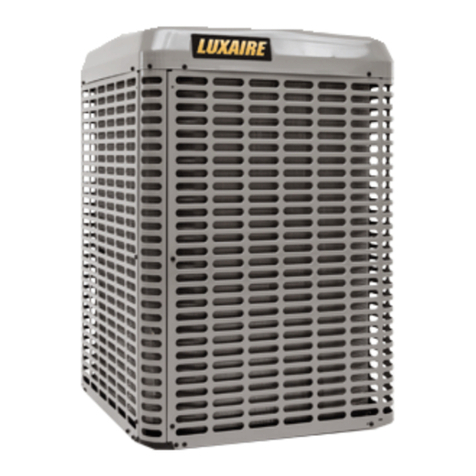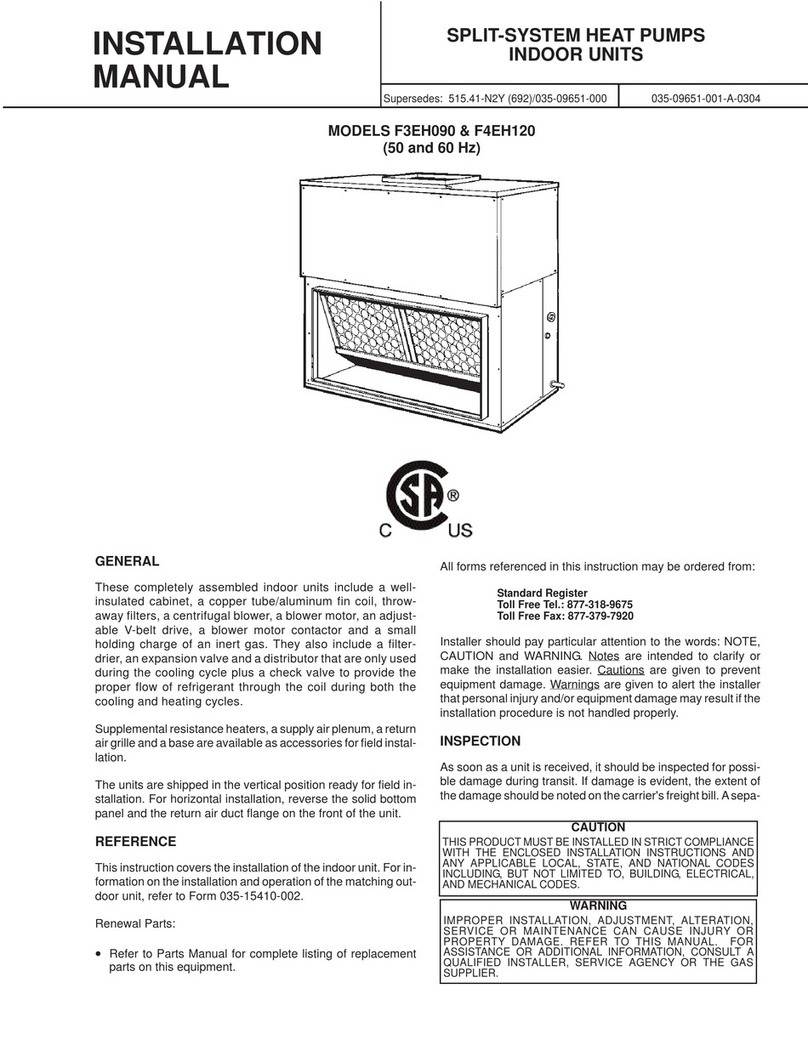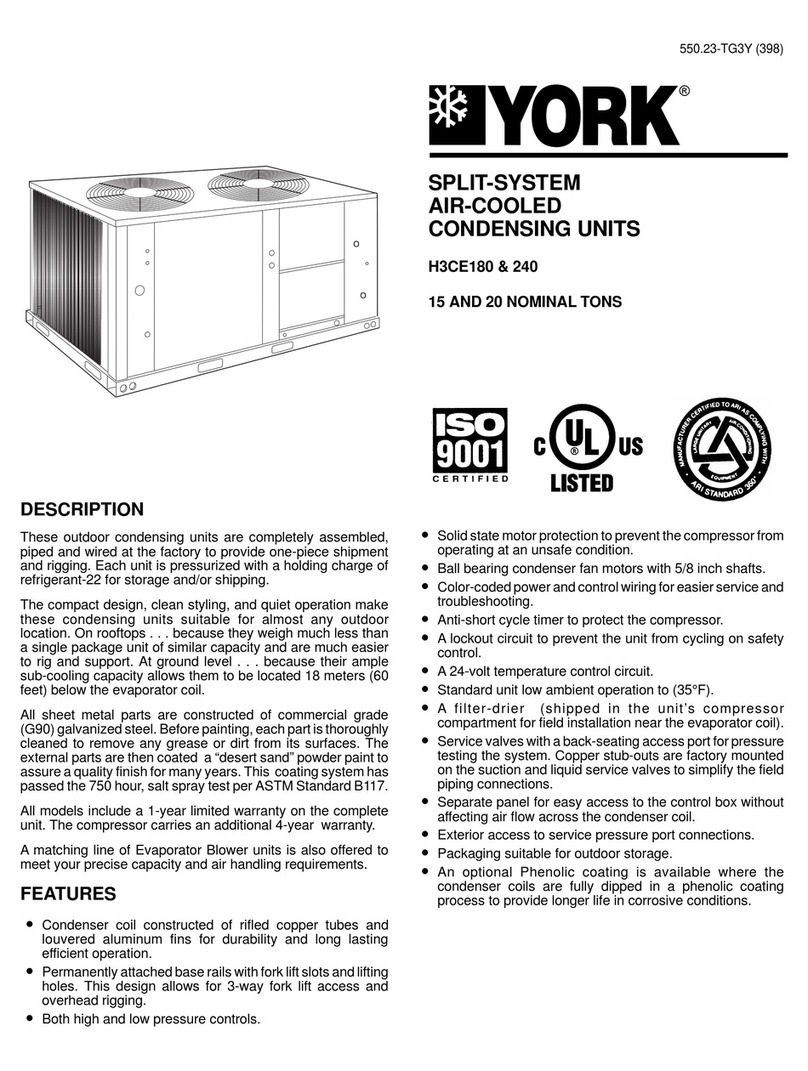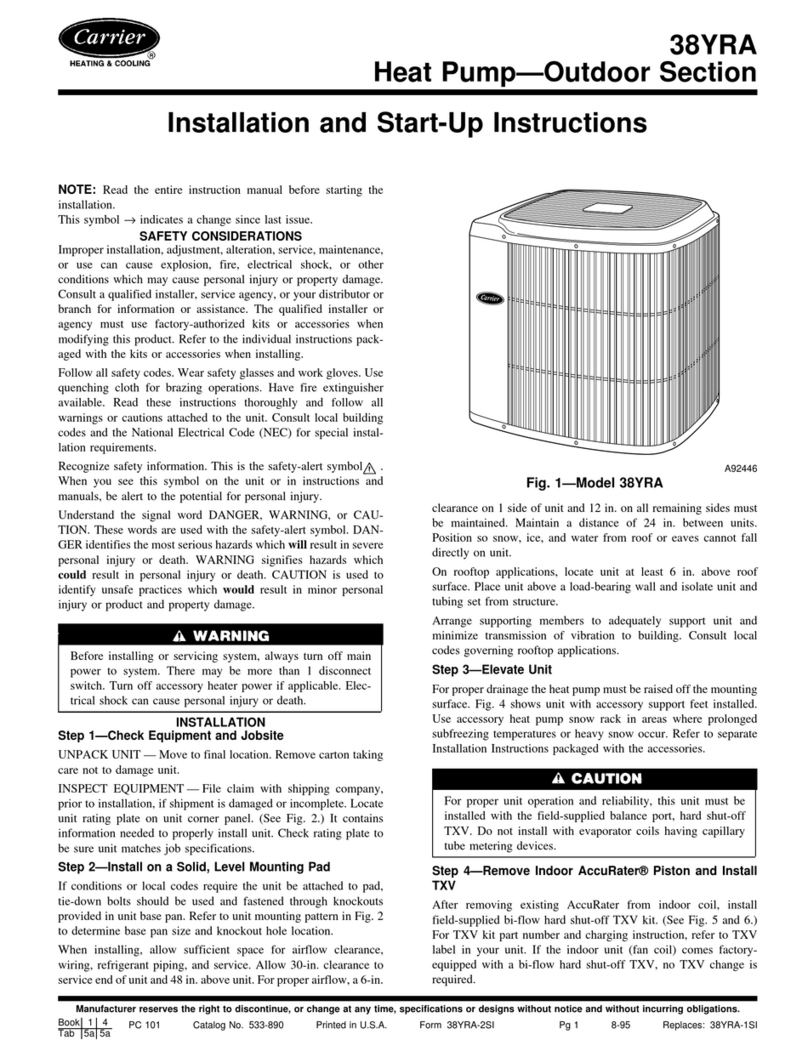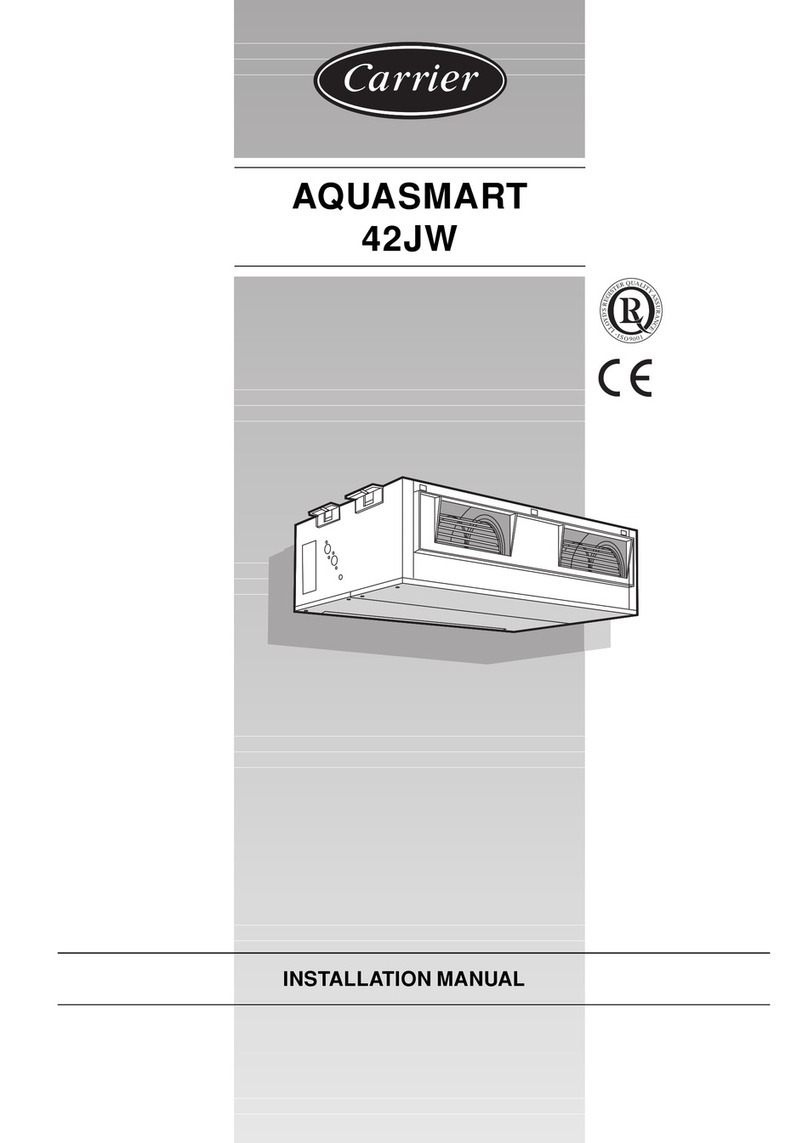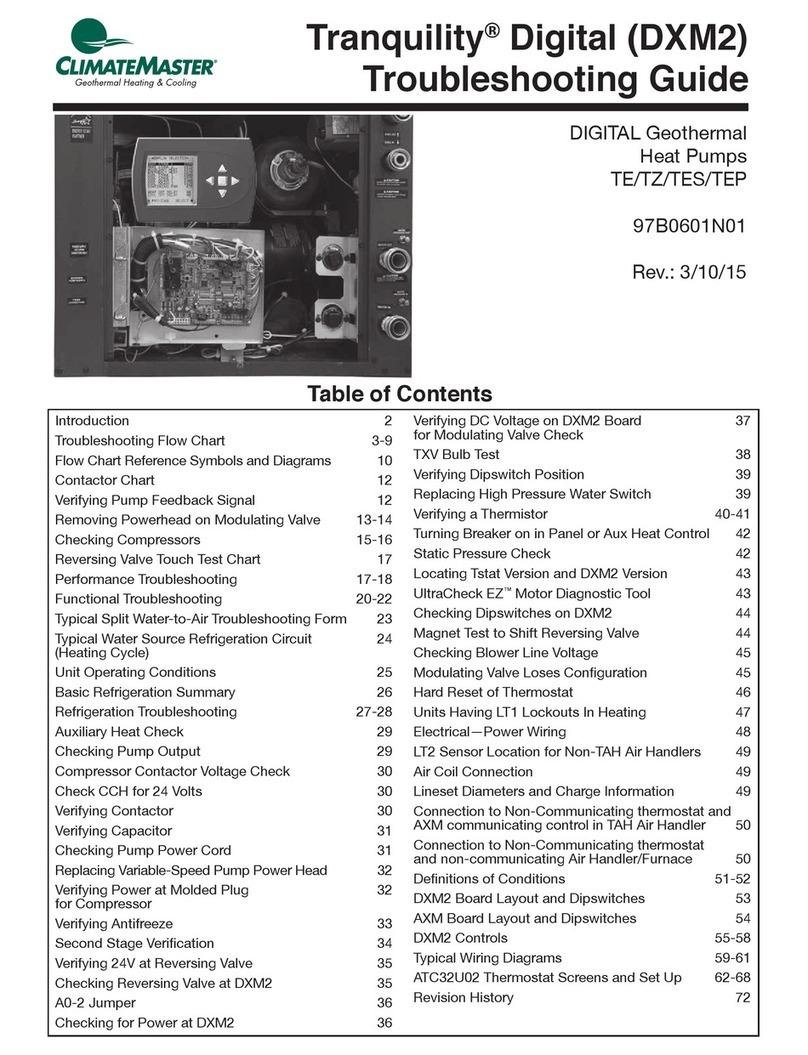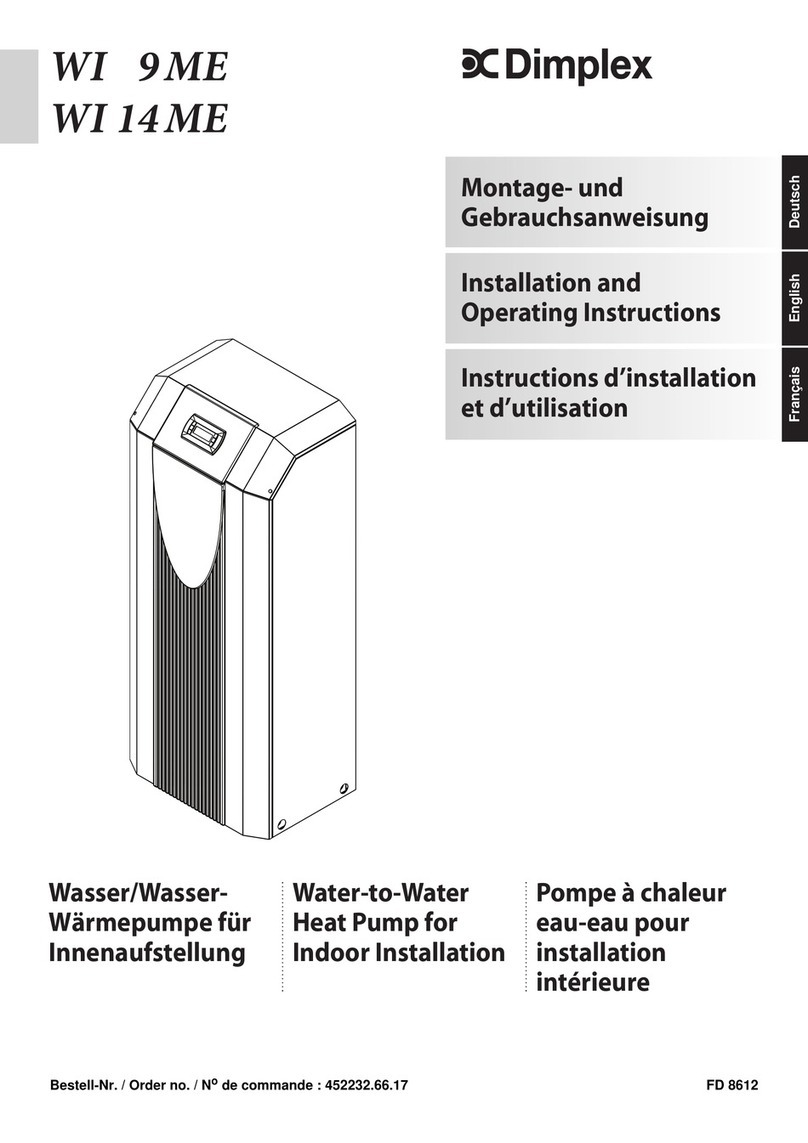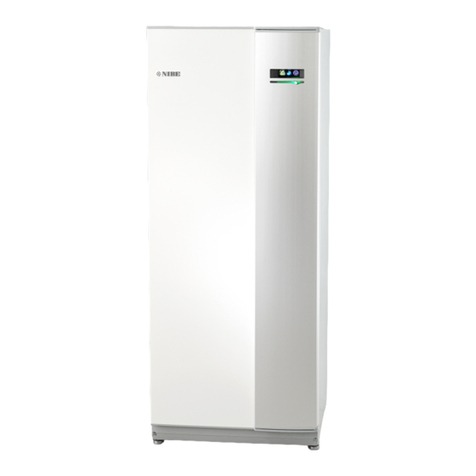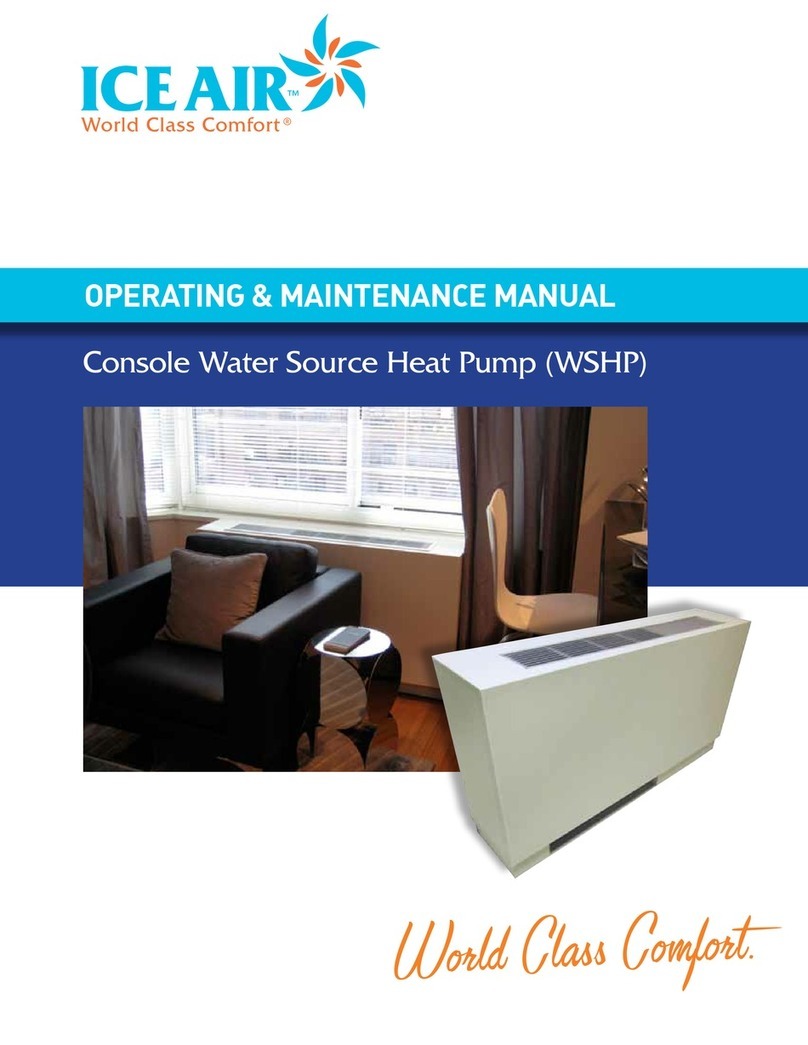TICA PRO TECA120BEDIC User manual

Air to water heat pump
-mono series
TIСA PRO LLC
141014, Russia, Moscow oblast, Mytishchi,
Very Voloshinoy Ulitsa, office 705 and 805
Tel.: +7(495)822-29-00
E-mail: [email protected]
www.tica.ru
INSTALLATION &
OPERATION MANUAL

Installation Manual of Inverter Type Household Air Source Heat Pump Chiller (Heat Pump)
Contents
Contents.....................................................................................................................1
I. Check List ..............................................................................................................1
II. Must-read for Users............................................................................................2
III. Product Overview...............................................................................................4
1. Overview................................................................................................................4
2. Outside View and Structure..............................................................................4
3. Specifications.......................................................................................................5
4. System Scheme...................................................................................................6
5. Features.................................................................................................................6
IV. Unit Installation ..................................................................................................7
1. Use instructions for air side products...........................................................7
2. Unit Installation and Connection Diagram ...................................................8
3. Pre-check ..............................................................................................................9
4. Place of Installation..........................................................................................13
5. Unit Installation..................................................................................................14
6. Installation of the Water System...................................................................16
7. Electrical Installation........................................................................................22
8. Trial operation....................................................................................................27
V. Operation and Use of Wired Controller.......................................................29
1. Screen description............................................................................................29
2. Interface Function.............................................................................................30
VI. Repair and Maintenance................................................................................32
VII. Common Faults...............................................................................................35
VIII. After-sales Service........................................................................................38
IX. Names and Content of Hazardous Substances in Products................39

Installation Manual of Inverter Type Household Air Source Heat Pump Chiller (Heat Pump)
1
I. Check List
Inspect the following items against the list after unpacking the product, and make sure that the unit comply with
the information on the nameplates. For any queries, consult your local distributor or call TICA hotline.
No.
Name
Qty
Instruction for Use
1
Unit
1 set
/
2
Qualification certificate
1
/
3
Installation & Operation
Manual
1
To guide unit installation and use
4
Wired controller
1
For controlling the unit
5
Communication line
1
For connecting unit and wired controller
6
Water filter
1
To facilitate unit external pipeline installation
7
Safety valve
1
To facilitate unit external pipeline installation
Note: Models involved
Air to water heat pump mono
series
TECA120/140/160BEDIC
TECA180/200/220BERIA

Installation Manual of Inverter Type Household Air Source Heat Pump Chiller (Heat Pump)
2
II. Must-read for Users
Read the Installation & Operation Manual thoroughly before installing and using the equipment and keep it for
future reference.
● Only TICA authorized personnel can install TICA air to water heat pump chiller. The installation must comply
with the requirements of the company. TICA assumes no liabilities for losses arising from improper operations,
including but not limited to pipe leakage, electric leakage and adverse effect or damages on the equipment.
● Reserve enough space for equipment installation strictly in accordance with the Manual. Otherwise, the heat
exchange effect may be compromised.
● Install a residual current device between the power supply and the equipment.
● When the equipment is available for commissioning upon installation, call TICA's hotline to request equipment
commissioning service. The equipment is usable only after a commissioning test is done. TICA assumes no
liabilities for any losses arising from unauthorized access to the equipment.
● The equipment shall undergo regular maintenance and servicing after it is installed. In case of an abnormality,
stop using it immediately and call TICA's hotline to report such event.
● Do not put your finger or other objects into a running equipment as it may cause personal injuries.
● If any parts are soaked in water, contact TICA's personnel to check or repair it before use again.
● Never drink or use the water in the unit for daily lives.
● All the circuits must be dedicated. The unit must be reliably grounded.
● Contact a qualified electrician to check electricity meter, circuit breaker and wire diameter to make sure that
they meet the maximum operating current requirement.
● If the ambient temperature is lower than 5°C and a power failure occurs, be sure to thoroughly drain water
from the unit and pipeline. If the ambient temperature is lower than 5°C and the water system is fully filled with
water, ensure that the unit is in the power-up state, and the chilled water circulating pump of the air conditioner
is interlocked with the unit. In this way, the unit can automatically control the water pump operation or heating
operation, thereby implementing automatic anti-freezing protection of the air conditioning water system. The
purpose is to protect facilities such as the unit and water pipeline against damage caused by freezing of water in
the pipeline of the air conditioning water system. When the unit is energized, the unit may consume a certain
amount of electricity to prevent it from freezing.
●The unit is prohibited from using open water systems.
● TICA assumes no liabilities for any losses arising from commissioning, maintenance or servicing by
unauthorized personnel or from using the equipment other than the purposes contained within this Manual.
● If the power cord is damaged, to avoid dangers, make sure to ask a professional from the manufacturer or its
maintenance department or similar department to replace it.
● Nanjing TICA Climate Solutions Co., Ltd. reserves the right to interpret this Manual.
Caution: Failure to observe this Manual may cause fire, losses, personal injury or
even be fatal.

Installation Manual of Inverter Type Household Air Source Heat Pump Chiller (Heat Pump)
3
Warning: The power supply of this equipment must be reliably grounded before
use. Within close proximity of the air to water heat pump chiller, there must be a
well-functioning floor drain. In addition, water leakage of the unit or from the joints in
the unit installation area shall not do any harm to adjacent items or the bottom floor
of the building.
Warning: Never use refrigerant to discharge the gas in the unit. Use the vacuum
pump for vacuumizing instead.

Installation Manual of Inverter Type Household Air Source Heat Pump Chiller (Heat Pump)
4
III. Product Overview
1. Overview
The inlet and outlet of the unit water pipes are connected to the air side products. In this way, the unit is able to
offer hot/cold water to each air side product, which could facilitate heat exchange in the room and therefore
heat/cool the room. It generally uses FCU for cooling and FCU, floor heating or radiator for heating. If using two
different types of air side products for heating in the same system, need to design suitable water system to
ensure the balance between water temperatures and resistances used at different air side products.
2. Outside View and Structure
(1) Outside view
(1) TECA120/140/160BEDIC TECA180/200/220BERIA
980
1260
1242
625
86 453
185 466
430
200
2-
φ
12
2-12×20
162
Water inlet
G1-1/4"
Water outlet
R1-1/4"
390
420

Installation Manual of Inverter Type Household Air Source Heat Pump Chiller (Heat Pump)
5
3. Specifications
Model
TECA120
BEDIC
TECA140
BEDIC
TECA160
BEDIC
TECA180
BERIA
TECA200
BERIA
TECA220
BERIA
Cooling
Capacity
12.0
14.0
16.0
18.0
20.0
21.0
Rated input
3.77
4.68
5.4
6.04
6.89
7.72
COPC (kW/kW)
3.18
2.99
2.96
2.98
2.90
2.72
Heating
Capacity
14.0
16.0
18.0
20.0
22.0
22.5
Rated input
4.09
4.73
5.37
6.1
6.77
7.25
COPh (kW/kW)
3.42
3.38
3.35
3.30
3.25
3.10
IPLV (C)
4.60
4.50
4.30
4.50
4.40
4.30
Circulating water flow (m3/h)
2.06
2.41
2.75
3.10
3.44
3.61
Pump type
Variable frequency canned pump
Power supply
220V~50Hz
380V 3N~50Hz
Maximum total power (kW)
7.30
7.30
7.30
10.0
10.0
10.0
Maximum operating current (A)
34.0
34.0
34.0
16.5
16.5
16.5
Applicable ambient
temperature
(℃)
Cooling
5~55
Heating
-25~43
Maximum permissible pressure on high
pressure side ( MPa)
4.2
4.2
4.2
4.2
4.2
4.2
Maximum permissible pressure on low
pressure side( MPa)
3.0
3.0
3.0
3.0
3.0
3.0
Maximum operating pressure of water
system( MPa)
0.5
0.5
0.5
0.5
0.5
0.5
Refrigerant/Charge quantity
R410A/
2.80kg
R410A/
2.80kg
R410A/
2.80kg
R410A/
3.85kg
R410A/
3.85kg
R410A/
3.85kg
Sound power level(dB (A))
55
55
56.5
57
57
57.5
Unit external lift (mH2O)
10.0
8.5
7.0
7.0
6.0
5.0
IP rating
IPX4,and applies to outdoor applications
Type of protection against electric
shock
I Class
Circulating
water pipe
connection
Water
inlet/outlet pipe
diameter
DN32
Connection
mode
External thread(R 1- 1/4’)
Weight( kg)
119
140
Notes:
1) Heating capacity : At rated water flow rate,outdoor air temperature 7⁰C DB, 6⁰C WB; LWT 45⁰C
Cooling capacity: At rated water flow rate,outdoor air temperature 35⁰C DB; LWT 7⁰C.
2) Due to the continuous improvement and innovation of TICAproducts, the product models, parameters and performance
in this document are subject to changes without prior notice. The parameters indicated on the nameplate should prevail.

Installation Manual of Inverter Type Household Air Source Heat Pump Chiller (Heat Pump)
6
3) Please refer to the maximum total power and maximum operating current during power distribution.
4) The unit has been charged with refrigerant.
4. System Scheme
The system scheme for this unit is provided below:
5. Features
(1) Powerful cooling/heating
By utilizing the EVI (Enhanced Vapour Injection) compressor, the unit is able to cool/heat the room via three
electronic expansion valves and overcome the problems of great attenuation for traditional air source heat
pump units at a low/high ambient temperature, thus greatly improving the heating/cooling capacity under
extreme temperatures.
(2) Power failure memory function
The wired controller can automatically store the unit status (ON/OFF) each time before the unit is powered
off. When the unit is powered on again, the wired controller sends power-on/off signal to the unit according
to the stored status before power-off, to ensure that the unit could operate as previously set.
(3) Multi-grade anti-freezing protection
At low ambient temperatures, in particular, when the ambient temperature is below 0°C, the water system
of the unit will most likely fail to work properly due to frozen water pipes. By utilizing TICA's unique
multi-grade anti-freezing technology, our unit could automatically determine when to enter or exit
anti-freezing protection under powered on, and therefore guarantee steady operation of the unit to the
greatest extent.
(4) Intelligent defrosting
In conditions with low ambient temperature and high relative humidity, the heating capability of the unit will
decrease with the accumulation of frost on the surface of the fin. To address this issue, the unit adopts a
control system to implement fast auto defrosting.

Installation Manual of Inverter Type Household Air Source Heat Pump Chiller (Heat Pump)
7
IV. Unit Installation
1. Use instructions for air side products
The system consists of unit and air side products (selected based on actual conditions). The air side product for
cooling can be a FCU; The air side product for heating can be a floor heating, FCU or radiator. It is
recommended to use floor heating as it requires lower water temperature while running with higher efficiency
and feel comfortable. If using radiator as the air side product for heating, use steel radiator. Steel radiator is also
a good fit as it features abundant volume of water capacity and reduced heat losses at a low water temperature.
When selecting the model of an air side product, note to calculate the load of it in light of local design standard.
If the model is inappropriate, the unit may be faulty or fail to provide adequate cooling/heating capacity.
If floor heating is used, observe relevant national standard or local standard on floor heating layout.
If FCU is used as an air side products for cooling/heating, consult your manufacturer on selecting appropriate
models and on installation.
If radiator is used as an air side product for heating, consult your manufacturer on selecting appropriate models
and on installation.
Taking into consideration of the unit features and to ensure reliable operation of the unit, the water outlet
temperature of the unit is lower than that of the boiler when the unit operates in winter. Therefore, if radiator is
used, add enough number of radiators to maintain the temperature in an acceptable range. The number of
radiators to be added depends on the attenuation coefficient of radiator. The user can also consult the radiator
manufacturer on the number to be added.
The air side products of this unit should meet the system cool/heat load, water pressure, water resistance and
water quality among other requirements.
Installation of the air side product shall comply with relevant standard or requirement of the manufacturer.
Notes:* Upon receiving the unit, check whether the unit model is correct,
accessories complete and the appearances of the unit intact. If you find
any damages or you have other problems, please immediately contact
with TICA.
* Before installation, make sure that the unit power is consistent with its
electricity meter capacity and power cords.
*The unit must be reliably grounded, and it is strictly forbidden to connect
the ground line to the null line or to the pipe.
* The unit must be reliably grounded. Never connect the earth line to the neutral
line or to the pipes.

Installation Manual of Inverter Type Household Air Source Heat Pump Chiller (Heat Pump)
8
2. Unit Installation and Connection Diagram
Three-way
valve
Automatic w ater
supply valv e
Drain
valve
Water
inlet
P
Gate valve
Floor heati ng
module 1 ...
Check
valve
Pressure
guageand
thermometer
(optional)
Gate
valve Manual ball
valve
Water purif ying
or deminera lized
water treat ment
device(optional)
Drain
valve
Expansion t ank
(optional)
Filter
Floor heati ng
module 2
Floor heati ng
module n
Gate valve
Differentia l
pressure
bypass valv e
Air dischar ge
valve
Water
filter
External
water pump
(optional)
Energy stor age
tank(optional)
Gate
valve
Water
collector/s eperator
FCUn
...
FCU2FCU1
Gate
valve
Gate
valve
Electric
two-way
valve
Gate valve
Gate
valve
Electric
two-way
valve
Electric
two-way
valve
Flexible
connector
Gate
valve
Diagram of combined FCU and floor heating
Note: 1) In FCU cooling mode, the FCU should be connected for cooling; while in FCU heating mode, floor
heating mode and floor heating preservation mode, the FCU, floor heating and radiators should be
connected for heating. It is not recommended to use two different types of air side products for heating
in the same system.
2) Except the unit, the user needs to prepare the air side products, connecting pipes and pipe fittings.
3) Decide whether the external water pump, energy storage tank, expansion tank, water purifying or
demineralized water treatment device, pressure gauge, thermometer, and differential pressure bypass
valve shown in the figures are needed according to the actual use conditions of the water system. If
the model does not have internal water pump, be sure to provide an external water pump to ensure
normal operation of the system. Provide other components based on the circumstances.
4) The air discharge valve needs to be installed at the highest position of the water system; the water
drain valve needs to be installed at the lowest position of the water system. The air discharge valve
should be installed where air discharge is unobstructed. It should avoid furniture and interior
decoration, lest water leakage of air discharge valve damage the furniture or interior decoration.
5) After the air side product system is debugged, do not adjust the pipeline system valve without
permission; otherwise the unit may fail to operate normally or be damaged.
6) The unit provides three-way valve control signal to realize water system switching between cooling
and heating.
Note: For an air side product, an electric two-way valve is recommended together with a differential
pressure bypass valve. The differential pressure bypass valve must ensure the minimum water
flow in the unit when only few FCUs are opened or all FCUs are closed. The purpose is to prevent
an excessive number of closed 2-way valves under partial load operating conditions. Otherwise,
the water resistance is too large, the pump is overloaded and damaged, the water flow fails, and
the unit cannot work properly.
When commissioning the water system, the water pump is set according to the actual on-site water
system. When all the air side products reach the temperature and stop, solenoid valve of the air side
product is closed and the water pump is also reduced to the lowest level. The setting of the differential
pressure bypass valve should ensure that the water flow at this time meets the minimum value (no flow

Installation Manual of Inverter Type Household Air Source Heat Pump Chiller (Heat Pump)
9
protection is reported, it is recommended to be greater than 1.5m³/h).If it is less than the minimum
value, you can lower the differential pressure bypass valve set value, or the pump set the lowest gear
higher.
3. Pre-check
(1) Water quality check
The water pumped into the unit must comply with the existing Sanitary Standard for Drinking Water. It is
recommended to use water with low hardness, preferably the softened water. Never use water from
seas, rivers or lakes or water directly from underground without treatment as it may damage the
precision parts of the unit.
If the water does not comply with the quality standard, it is necessary to install water purifying or
softening devices at the water inlet.
Do not use the scale inhibitor or preservatives until they are confirmed to be non-corrosive to stainless
steel or copper products and to be unharmful to the unit’s heat exchanging ability.
The water quality requirements for the use of the unit's built-in plate heat exchanger are as follows.
Type
Concentration
mg/l or ppm
Material
AISI 316L
Cuprum
pH
< 6
o
o
6 - 7,5
o
o
7,5 - 9
+
+
> 9
+
o
alkalinity
HCO3¯
< 70
+
o
70 - 300
+
+
> 300
+
o
sulphate
SO42¯
< 70
+
+
70 - 300
+
-
> 300
+
-
alkalinity/sulphate
HCO3¯/
SO42¯
> 1
+
+
< 1
+
-
conductivity
μS/cm
< 10
+
o
10 - 500
+
+
> 500
+
o
ammonia
NH4
< 2
+
+
2 - 20
+
o
> 20
+
-
< 1
+
+

Installation Manual of Inverter Type Household Air Source Heat Pump Chiller (Heat Pump)
10
Cl
Cl2
1 - 5
-
o
> 5
-
-
Hydrogen sulfide
H2S
< 0,05
+
+
> 0,05
+
-
Free carbon dioxide
(corrosive)
CO2
< 5
+
+
5 - 20
+
o
> 20
+
-
nitrate
NO3¯
< 100
+
+
> 100
+
o
Iron
Fe
< 0,2
+
+
> 0,2
+
o
Aluminum
Al
< 0,2
+
+
> 0,2
+
o
Manganese (Mn)
Mn
< 0,1
+
+
> 0,1
+
o
Chloride
content (Cl¯)
Maximum temperature
60°C
80°C
120°C
130°C
≤10 ppm
AISI 304L
AISI 304L
AISI 304L
AISI 316L
≤25 ppm
AISI 304L
AISI 304L
AISI 316L
AISI 316L
≤ 5 0 ppm
AISI 304L
AISI 316L
AISI 316L
≤ 8 0 ppm
AISI 316L
AISI 316L
AISI 316L
≤ 150 ppm
AISI 316L
AISI 316L
≤300 ppm
AISI 316L
+
Goodtolerability
o
When the composition is yellow, corrosion may occur
-
Notrecommended BPHE/MPHE
Note: It should be noted that this water quality specification does not absolutely guarantee corrosion protection,
but these factors must be taken into account in the water used to avoid serious problems.
(2) Water volume check
Model
Minimum water volume (Vmin)

Installation Manual of Inverter Type Household Air Source Heat Pump Chiller (Heat Pump)
11
TECA120BEDIC
100L
TECA140BEDIC
120L
TECA160BEDIC
140L
TECA180BERIA
150L
TECA200BERIA
160L
TECA220BERIA
170L
The water volume of the cooling/heating water system should be checked separately, and both should meet the
requirement of the minimum water volume mentioned above.
Water system volume (V) check: a. When V ≥ Vmin, no energy storage tank is required.
b. When V < Vmin, add an energy storage tank
(tank volume: Vn ≥ Vmin - V)
Notes:
1) The energy storage tank must be a closed pressurized tank.
2) The energy storage tank must be insulated well.
3) The pressure bearing capacity of the tank must comply with the system requirement.
4) The diameter of inlet and outlet pipe of the energy storage tank shall not be less than that of the main pipe
of the water system.
5) Installation of the tank must comply with the requirements of its manufacturer.
(3) Expansion tank selection and check
1) Expansion tank check
(Applicable to TECA120/140/160BEDIC and TECA180/200BERIA units)
The unit has a built-in expansion tank 2 L) with initial pressure of 0.15 MPa and allowable water storage
capacity of 170 L.
If the actually required water volume is greater than 170 L, add expansion tanks.
When adding an expansion tank, use the following formulas to calculate the needed volume:
Vb=0.023*(V-170)
V–actual water system volume (unit: L)
Vb–active volume of expansion tank (unit: L)
(4) Water pump model selection and determination of water resistance
1) The water system resistance under the least favorable conditions is calculated by the following formula:
Hmax=△P1+△P2+△P3
Notes: △P1——Water pressure drop within the unit
△P2——Water pressure drop (unit: m) of the water pump (or some water pumps) with greatest
water pressure losses among all the parallel air side products within the least favorable
loop
△P3——Resistance losses of main pipe within the least favorable loop (unit: m)
Please refer to relevant manuals and parameters of air side products when calculating the above resistances.
The water pressure drop within the unit is described as follows:

Installation Manual of Inverter Type Household Air Source Heat Pump Chiller (Heat Pump)
12
Model
Circulating water flow
(m3/h)
Internal pressure
drop (m)
Unit external
lift (m)
Remarks
TECA120BEDIC
2.06
/
10.0
Provided with water pump
TECA140BEDIC
2.41
/
8.5
Provided with water pump
TECA160BEDIC
2.75
/
7.0
Provided with water pump
TECA180BERIA
3.10
/
7.0
Provided with water pump
TECA200BERIA
3.44
/
6.0
Provided with water pump
TECA220BERIA
3.61
/
5.0
Provided with water pump
2) Water pump check
(Applicable to TECA120/140/160BEDIC and TECA180/200/220BERIA units)
The unit has a built-in circulating water pump, and the lift/flow curve is shown as below:
Test the pump lift and flow against the water system resistance under the least favorable conditions. When the
lift or flow of the built-in pump cannot meet the system requirements under the least favorable conditions, add
external water pumps and external water pump and built-in water pumps should start and stop together. To

Installation Manual of Inverter Type Household Air Source Heat Pump Chiller (Heat Pump)
13
select and install an external water pump, please consult the water pump manufacturer.Generally, keep the
external water pump and built-in water pump running in series to increase the lift, but note that the selected
external pump must match the built-in pump in terms of its characteristic flow curve.
For the water system installation of TECA200/220BERIA, if the indoor FCUs are opened at more than 80% at
the same time during use, the air side water flow may be insufficient. It is recommended to add an external
water pump or a secondary pump system to ensure the air side water flow.
3) Model selection of water pump
(Applicable to TECA120/140/160BEDIC and TECA180/200/220BERIA units)
To select and install a water pump, please consult the water pump manufacturer.
The lift of the water pump must meet water system resistance calculated under the least favorable conditions.
The water pump flow should meet the required water flow indicated on the unit nameplate.
4. Place of Installation
When installing, note that:
installation site requirements:
Unit is installed on the ground or on the roof or wall that is sturdy enough to support the unit. Sufficient
installation and maintenance spaces must be reserved.
Air outlet or inlet of unit is unimpeded to ensure enough air flow for heat exchanging; in the meantime,
prevent the cold air generated by the unit from affecting its surroundings.
Avoid installation of unit on a noise- or vibration-sensitive place, lest it may disturb the residents within
its proximity.
Shock absorbing device must be installed on unit to prevent vibration from spreading over the building.
Choose a well-drained place to install unit, to make sure that no water accumulates.
If installed in a place where people have easy access to the unit, use safety measures, such as fences,
to avoid unit damages or personal injuries.
To ensure normal operation of the unit, avoid the air outlet of unit from the windward direction during the
cooling or heating season.
Do not install the unit in a closed space (such as courtyard), lest the heat exchanging effect of the unit
be dampened.
When installing the unit, avoid places with acid or alkaline substance or corrosive gas.
When installing the unit, avoid places where plenty of oil, fiber, dust, and volatile flammable gases (such
as gasoline and lacquer petroleum) exist.
When installing the unit, avoid the atmospheric environment containing oil sources (including engine
oil), salt (marine area), or sulfide gas (the neighborhood of hot spring or oil refinery), or other corrosive
gases, because these substances may easily cause unit failures.
When installing the unit, avoid strong power and strong magnetic field.
Install the unit in a place with easy access to water supply and drainage.
Danger: Never install the unit in a flammable atmosphere. Keep the unit away from fire and explosives.

Installation Manual of Inverter Type Household Air Source Heat Pump Chiller (Heat Pump)
14
The installation space of the unit is shown as follows.
(1) TECA120/140/160BEDIC、TECA180/200/220BERIA
Air outlet
>2000
Air inlet
>300
Air inlet
>300
>600
For wire
and piping
maintenance
Base
Support
5. Unit Installation
(1) Floor mounting
The unit must be installed on a durable foundation which is at least 120 mm high above the ground.
Avoid wet or corrosive places lest the unit may be damaged. The foundation shall have a smooth
surface.
A metal bracket must be installed on the foundation as this may facilitate water drainage when
defrosting. With a height not less than 300 mm and local maximum snow thickness, the bracket must
be stable, anti-corrosive, and strong enough to bear the unit weight and to keep its shape after long
period of use.
The metal bracket is customized based on the unit's dimensions, weight and installing holes.
The metal bracket should be securely fixed to the foundation through at least four sets of expansion
bolts (M10 or larger size). In addition, flat gaskets and the spring gaskets must be arranged on the bolt.

Installation Manual of Inverter Type Household Air Source Heat Pump Chiller (Heat Pump)
15
Installation of expansion bolts should comply with relevant standards and requirements.
The bracket must be horizontal upon installation, and could bear the unit's weight whenever it is
operating, installed or repaired.
Four sets of M10 bolts are used to fix the unit to the metal bracket. Arrange the bolts in a downward
direction and with the matching flat gaskets and spring gaskets added.
Install a shock absorbing device between the unit and metal bracket to ensure that the unit is securely
fixed.
Stainless steel bolts are desirable; otherwise, the bolts must undergo antiseptic treatment. Make sure
that the bolts are not corroded after long-term use.
(2) External wall mounting
Install the unit on concrete or bearing structures. Never fix it on hollow brick wall, cob wall or similar
structures which are unlikely to bear the unit’s weight.
The wall where the unit is mounted shall be flat.
The metal bracket for supporting the unit is customized based on the unit’s dimensions, weight and
installing holes.
The metal bracket must be anti-corrosive, and strong enough to bear the unit weight and to keep its
shape after long-term use.
The bracket shall be at least 300 mm high above the ground, and not lower than the local maximum
snow thickness.
The metal bracket should be fixed to the bearing wall through at least six sets of expansion bolts (M10
or larger size). Crossing bolts are required if the wall is thin or not strong enough. In addition, flat
gaskets and the spring gaskets must be arranged on the bolt. Installation of bolts should comply with
relevant standards and requirements.
The bracket must be horizontal upon installation, and could bear the unit’s weight whenever it is
operating, installed or repaired.
Four sets of M10 bolts are used to fix the unit to the metal bracket. Arrange the bolts in a downward
direction and with the matching flat gaskets and spring gaskets added.
Install a shock absorbing device between the unit and metal bracket to ensure that the unit is securely
fixed.
Stainless steel bolts are desirable; otherwise, the bolts must undergo antiseptic treatment. Make sure
that the bolts are not corroded after long-term use.
Notes:
Handle the unit with care as it is heavy and its center of gravity is not right at its center.
Don’t tilt the unit exceeding 45°.
Note to control the drainage of defrosted water in such a way that it may not cause excessive water
accumulation or freezing, as it may cause foot slipping or other personal injuries.
In snowy areas, the following measures should be taken to ensure the safe operation of the unit:

Installation Manual of Inverter Type Household Air Source Heat Pump Chiller (Heat Pump)
16
1. Set up a canopy to avoid snow
2. The unit should stay above the snow that might accumulate on the ground
Wall mounting is not recommended for a noise- or vibration-sensitive place, as the noise and
vibration may pass into the room.
(3) Insulating layer
Apply glue to and wrap the joints of heat insulation pipes with thin adhesive tape (one side adhesive).
Use a knife to cut the tape. Do not use your hands to tear it apart.
Leave no gaps at the joints of heat insulation pipes.l.
Wrap tightly the joints of insulating materials with PVC adhesive tape.
Never use ribbon to wrap the insulating layer, lest the insulation effect may be affected.
6. Installation of the Water System
(1) Water system pipeline connection
1) Requirements for water system pipeline connection
Do the waterway connection according to the above water system connection diagram.
The pipes and accessories selected for the water system shall comply with relevant standard.
The main water supply and return pipes that connect each air side product shall have a diameter not
less than that of inlet/outlet pipes. Steel pipes (DN32 or above) or PPR pipes (DN40 or above) are
preferable.
The connection pipes shall be resistant to corrosion.
Notes:
Only after the unit is fixed can it be connected to inlet/outlet pipes.
To ensure water resistance balance, install the water system of the unit in
reverse return manner.
A water filter shall be installed at the water inlet pipe of this system in a
manner that is convenient and easy for removal and cleaning. In addition,
the installation direction and filter screen direction should be considered.
To ensure the effectiveness of the use and normal operation of the unit,
the inlet and outlet pipes of the unit must be properly insulated.
Keep pipes of the system clean and away from pollutants to prevent dusts
or other external matters from entering the pipe system during installation.

Installation Manual of Inverter Type Household Air Source Heat Pump Chiller (Heat Pump)
17
The connection pipes have to withstand pressure of not less than 1 MPa.
The connection pipes have to withstand temperature of not less than 70°C.
Be sure that the water pipes and accessories are free from cracks outside and foreign matters inside.
The piping connection must be carried out in a way that facilitates maintenance and servicing.
Pipes and pipe joints must be supported independently and reliably.
Try to avoid electrical parts, cables when carrying out piping connection, as the water may leak and
hence cause safety accidents.
The water filter must be installed as required and the water inlet pipe of the unit must be connected
with the loose nut of the water filter. Make sure that the fluid flow and the arrow indicated on the filter
are in the same direction(as shown in the following figure). Note that the sealing washer should be
added between the water filter and the unit. Install the filter where it is easy for maintenance(Note that
the hexagonal head cover should be placed downward or horizontally, not upward). After installation,
the water filter should be insulated.
Gate valves must be installed on the inlet/outlet pipes of the unit, as they could cut off IDU water flow
when repairing.
Flexible joints should be used between the unit interface and the field pipeline to reduce vibration
propagation and hence to protect the pipeline.
A drainage outlet should be set at the low positions of the water system so that the water can be
completely discharged from the heat exchanger and the system; an air discharge valve should be set at
the high positions to eliminate air from the pipeline. The drainage outlet and air discharge valve must be
set where it is easy for maintenance.
After the piping connection of water system is completed, use a dedicated water pump to flush the
pipelines. Disconnect the unit from the water system when flushing.
After that, connect the water system to unit for a pressure test to see whether the system leaks.

Installation Manual of Inverter Type Household Air Source Heat Pump Chiller (Heat Pump)
18
After the pressure test, insulate the inlet and outlet pipes properly, lest heat losses, condensation or
freezing may occur.
2) Precautions
Decide whether or not to install the energy storage tank, external water pump, expansion tank, water
purifying or demineralized water treatment device, pressure gauge and thermometer according to the
on-site conditions.
After piping connection, rinse the water system before it can be connected to the unit.
Piping design may vary with the actual conditions. For details, refer to the relevant design standard.
Connect the inlet and outlet pipes in the correct direction.
Make sure that the water filter is installed on the water inlet pipe of the unit.
This unit applies only to a closed water system. If applied to an open water system, the water pipes may
be corroded.
Make sure that the safety valve could discharge water smoothly.
Never test or run the water system beyond the designed pressure of 0.5 MPa. During idle time,
maximum water pressure of the system cannot exceed 0.5 MPa.
3) Installation of automatic water supply valve (prepared by user)
When installing automatic water supply valve, please refer to the requirements of its manufacturer.
Automatic water supply valve should be installed on the system’s return water side.
Replace or clean the valve core when it becomes dirty.
Diagram of installing automatic water supply valve is shown below.
P
Automatic water
supply valve
Manual ball
valve
Water supply
mouth (tap
water pipe)
Connect to
water return
pipe of the unit
Water purifying or
demineralized water
treatment device
Filter
Notes: The manual water supply valve in the above diagram is used to reduce the first water supply time and
accelerate water supply process. After charge is finished, close the manual ball valve and open the
automatic water supply valve (for details, please refer to manual of automatic water supply valve).
4) Installation precautions of expansion tank
The purpose of expansion tank is to maintain the pressure balance of the water system. When
installing the expansion tank, please refer to the requirements of the manufacturer.
The expansion tank is usually installed at the highest point at the suction end of the system circulating
water pump.
The expansion tank should be installed indoors to ensure that the ambient temperature is not less than
0 °C in winter to prevent frost damage.
This manual suits for next models
5
Table of contents
Other TICA Heat Pump manuals
Popular Heat Pump manuals by other brands

poolstar
poolstar POOLEX SILENTMAX 80 Installation and user manual

Thermics
Thermics LUNA 2T installation manual
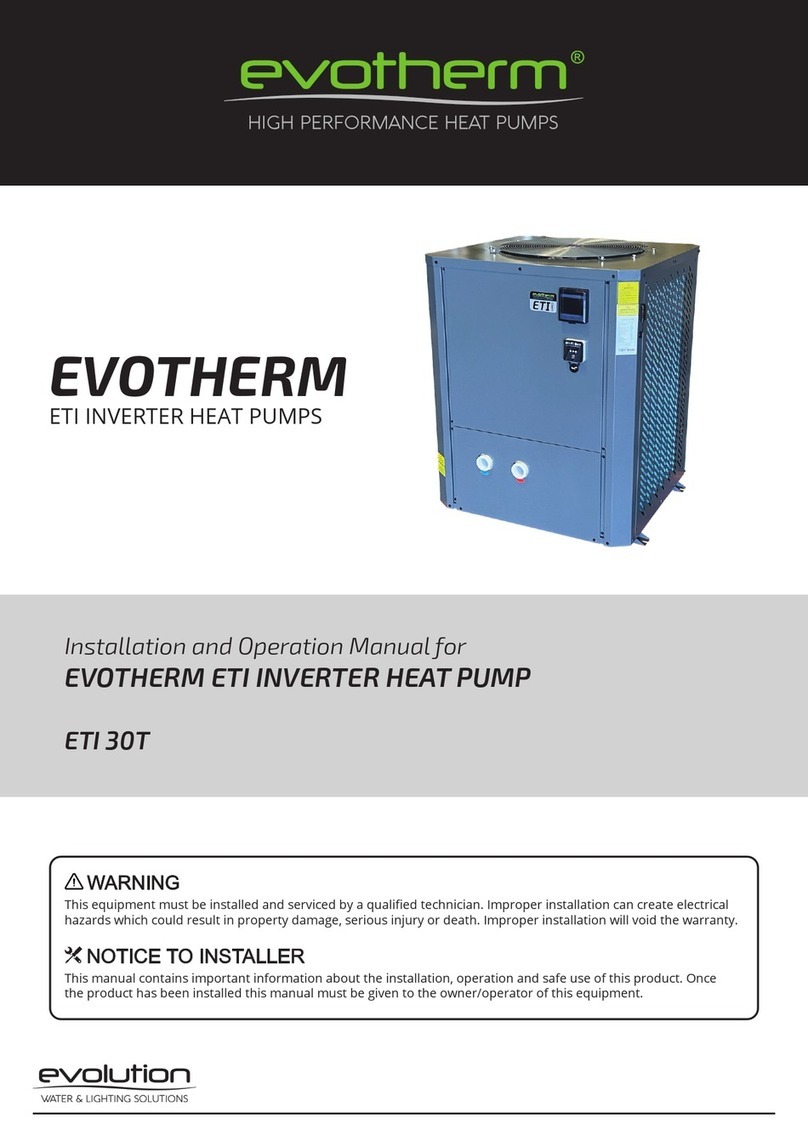
Evolution
Evolution evotherm ETI 30T Installation and operation manual
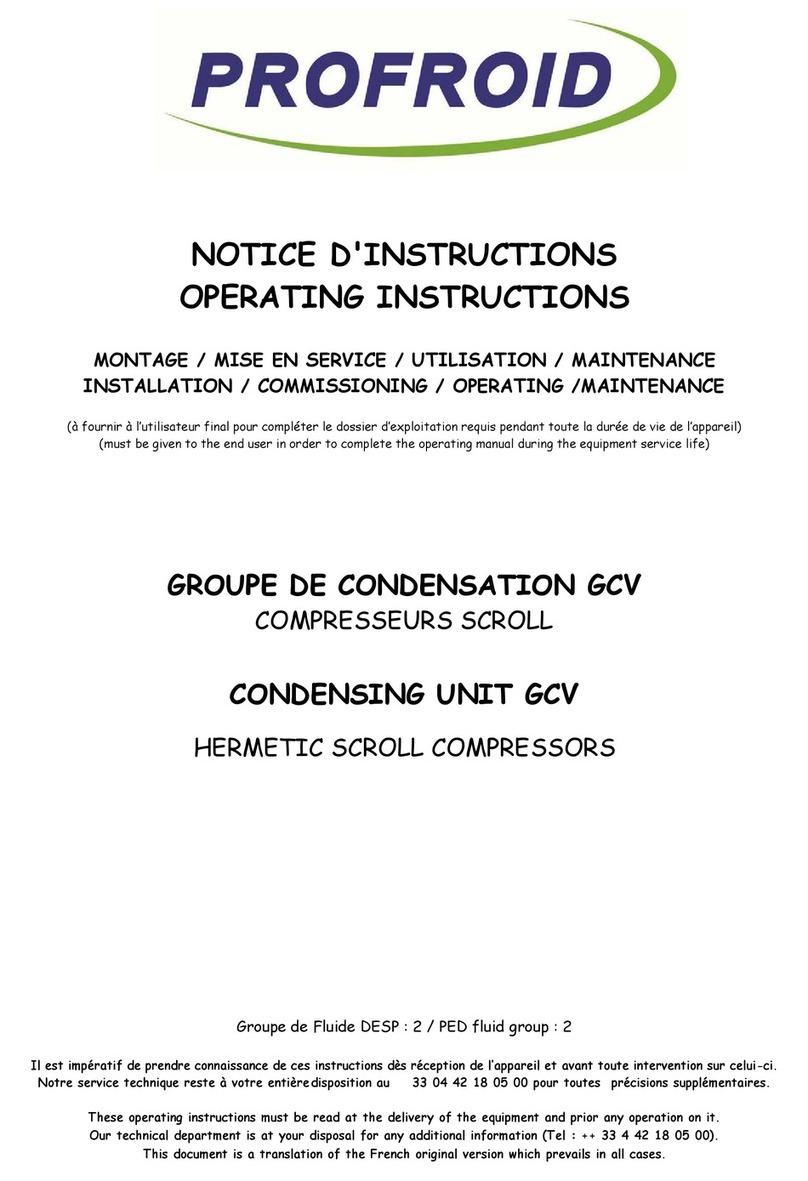
Profroid
Profroid GCV B2H ZF15 operating instructions

LG
LG LC248HV Engineering manual
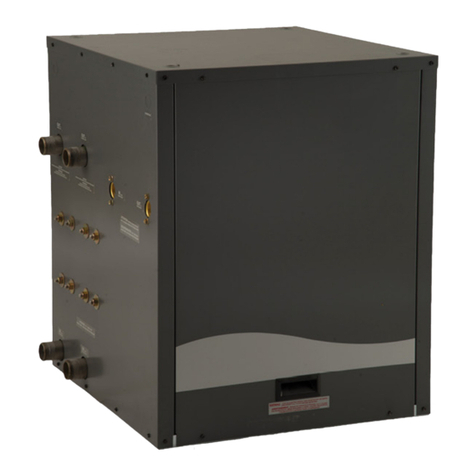
Enertech
Enertech WS Series Engineering data and installation manual

